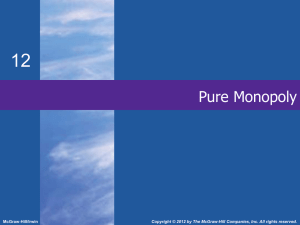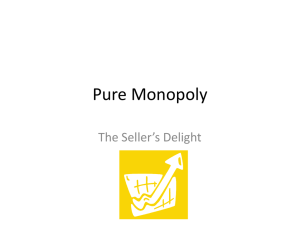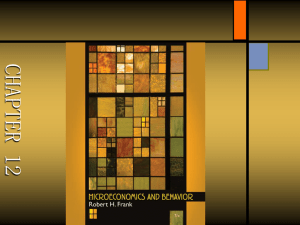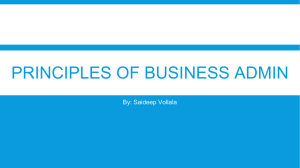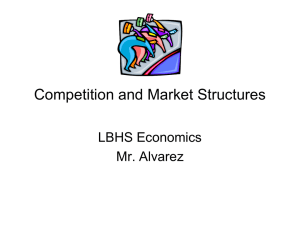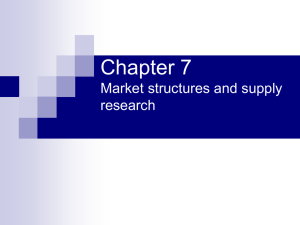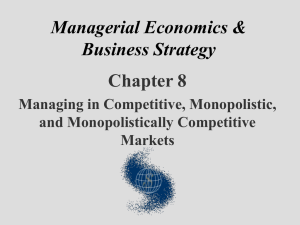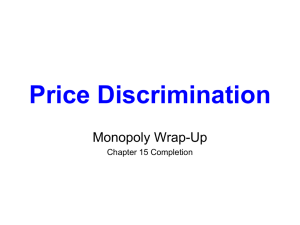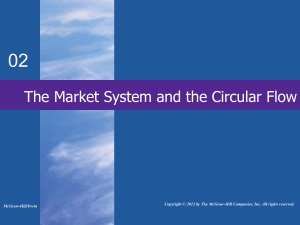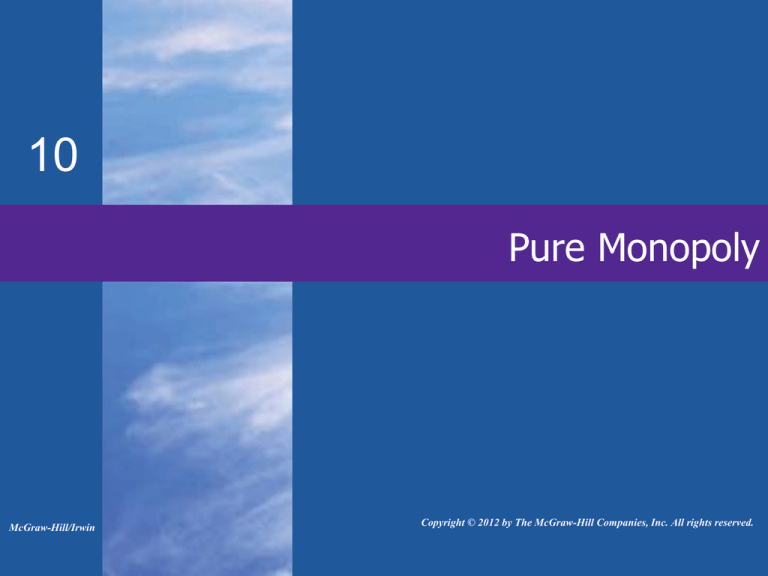
10
Pure Monopoly
McGraw-Hill/Irwin
Copyright © 2012 by The McGraw-Hill Companies, Inc. All rights reserved.
An Introduction to Pure Monopoly
• Single seller – a sole producer
• No close substitutes – unique product
• Price maker – control over price
• Blocked entry – strong barriers to
•
LO1
entry block potential competition
Non-price competition – mostly PR or
advertising the product
10-2
Examples of Monopoly
• Public utility companies
• Natural Gas
• Electric
• Water
• Near monopolies
• Intel
• Wham-O
• Professional Sports Teams
LO1
10-3
Barriers to Entry
• Barrier to Entry: a factor that keeps
firms from entering an industry.
• Economies of Scale
• Legal Barriers: Patents and
Licenses
• Ownership of Essential Resources
• Pricing
LO1
10-4
Average total cost
Economies of Scale
$20
15
0
LO1
ATC
10
50
100
Quantity
200
10-5
Monopoly Demand
• The pure monopolist is the industry
• Demand curve is the market demand
•
LO1
curve
• Downsloping demand curve
Marginal revenue is less than price
10-6
Monopoly Demand
Table 10.1 Revenue and Cost Data of a Pure Monopolist
Revenue Data
(1)
Quantity
of Output
LO1
Cost Data
(2)
Price
(Average
Revenue)
(3)
Total
Revenue
(1) X (2)
0
$ 172
$0
1
162
162
2
152
304
142
3
142
426
4
132
5
(4)
Marginal
Revenue
(5)
Average
Total Cost
(6)
Total Cost
(1) X (5)
(7)
Marginal
Cost
$ 100
$ 162 $ 190.00
(8)
Profit (+)
or
Loss (-)
$ -100
190
$ 90
-28
135.00
270
80
+34
122
113.33
340
70
+86
528
102
100.00
400
60
+128
122
610
82
94.00
470
70
+140
6
112
672
62
91.67
550
80
+122
7
102
714
42
91.43
640
90
+74
8
92
736
22
93.75
750
110
-14
9
82
738
2
97.78
880
130
-142
10
72
720
-18
103.00
1030
150
-310
10-7
Monopoly Demand
• All customers must pay the same price
$142
132
122
112
102
Loss = $30
D
Gain = $132
92
82
0
LO1
1
2
3
4
5
6
10-8
Monopoly Demand
• All customers must pay the same price
$142
132
122
112
102
Loss = $30
D
Gain = $132
92
82
MR
0
LO1
1
2
3
4
5
6
10-9
Monopoly Demand
• Marginal Revenue < Price
• Monopolist is a price maker
• Monopolist sets prices in elastic
region of demand curve
LO2
10-10
Output and Price Determination
Demand and Marginal-Revenue Curves
Elastic
$200
Inelastic
Price
150
100
50
D
MR
Total Revenue
0
4
$750
6
8
10
12
Total-Revenue Curve
14
16
18
500
250
0
LO2
2
TR
2
4
6
8
10
12
14
16
18
10-11
Output and Price Determination
Steps for Graphically Determining the Profit-Maximizing Output, ProfitMaximizing Price, and Economic Profits (if Any) in Pure Monopoly
Step 1
Determine the profit-maximizing output by finding where MR=MC.
Step 2
Determine the profit-maximizing price by extending a vertical line
upward from the output determined in step 1 to the pure monopolist’s
demand curve.
Step 3
Determine the pure monopolist’s economic profit by using one of two
methods:
Method 1. Find profit per unit by subtracting the average total cost of
the profit-maximizing output from the profit-maximizing price. Then
multiply the difference by the profit-maximizing output to determine
economic profit (if any).
Method 2. Find total cost by multiplying the average total cost of the
profit-maximizing output by that output. Find total revenue by
multiplying the profit-maximizing output by the profit-maximizing
price. Then subtract total cost from total revenue to determine the
economic profit (if any).
LO2
10-12
Output and Price Determination
Price, Costs, and Revenue
$200
175
Pm=$122
MC
150
125
100
75
Economic
Profit
ATC
D
A=$94
MR=MC
50
25
0
LO2
MR
1
2
3
4
5
6
Quantity
7
8
9
10
10-13
Misconceptions of Monopoly Pricing
• Not highest price
• Total profit
• Possibility of losses
LO2
10-14
Price, Costs, and Revenue
Misconceptions of Monopoly Pricing
MC
A
Pm
ATC
Loss
AVC
V
D
MR=MC
MR
0
Qm
Quantity
LO2
10-15
Economic Effects of Monopoly
Pure competition is efficient
Monopoly is inefficient
S=MC
MC
P=MC=
Minimum
ATC
Pc
Pm
Pc
b
d
c
a
D
D
MR
Qc
(a)
Purely Competitive Market
LO3
Qm Qc
(b)
Pure Monopoly
10-16
Economic Effects of Monopoly
• Income transfer
• Cost complications
• Economies of scale
• X-Inefficiency
• Rent seeking expenditures
• Technological advance
LO3
10-17
Average total costs
X-Inefficiency
ATC1
X'
ATCx'
Average
total cost
ATC2
0
LO3
X
ATCx
Q1
Quantity
Q2
10-18
Assessment and Policy Options
• Antitrust laws
• Break up the firm
• Regulate it
• Government determines price and
•
LO3
quantity
Ignore it
• Let time and markets get rid of
monopoly
10-19
Global Perspective
Competition from Foreign Multinational Corporations
LO3
10-20
Price Discrimination
• Price discrimination
• Charging different buyers different
•
LO4
prices
• Price differences are not based on
cost differences
Conditions for success:
• Monopoly power
• Market segregation
• No resale
10-21
Examples of Price Discrimination
• Business travel
• Electric utilities
• Movie theaters
• Golf courses
• Railroad companies
• Coupons
• International trade
LO4
10-22
Graphical Analysis
P
P
Economic
profit
Pb
Economic
profit
MC = ATC
Qb
MRb
Db
(a) Small businesses
LO4
Ps
MC = ATC
Qs
Ds
MRs
(b) Students
10-23
Regulated Monopoly
• Natural monopolies
• Socially optimal price
• Set price = marginal cost
• Fair return price
• Set price = ATC
LO5
10-24
Price and Costs (Dollars)
Regulated Monopoly
Monopoly
Price
Pm
Pf
Fair-Return
Price
a
f
Pr
r
MR
0
LO5
Socially
Optimal
Price
Qm
b
Qf
Quantity
ATC
MC
D
Qr
10-25
De Beers’s Diamonds
• De Beers once controlled about 80%
•
•
of the world’s diamond market
Monopoly position eroded over time
• New diamond discoveries
• Nearly perfect artificial diamonds
• Unfavorable media attention
Now focus on increasing demand for
diamonds rather than controlling
supply
10-26

